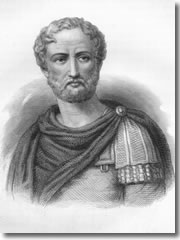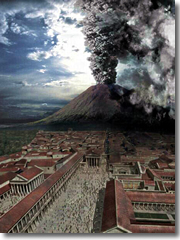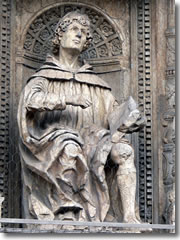- Places
- Plans
- Itineraries
- Experiences
Brief bios of Pliny the Elder and his nephew Pliny the Younger, ancient Roman scientists and choniclers

Gaius Plinius Secundis.Pliny the Elder (Gaius Plinius Secundis) was an ancient Roman historian and natural pholosopher whose Naturalis Historia, a 37-volume treatise of natural philosophy, contained pretty much the sum of all knowledge at the time. In essence, he wrote (by himself) the Wikipedia of the AD 1st century
A buddy of the emperor Vespasian, Pliny help various political posts throughout the empire which allowed him to travel wildely—notably Northern Africa, Spain, and Gallia Belgica (modern-day Belgium, the Netherlands, and Luxembourg along with bits of Northern France and Germany).
Pliny was also a journalist of the old school who once said, "True glory consists in doing what deserves to be written; in writing what deserves to be read."
He died according to his own axiom.
Though he hailed from the town of Como on Lake Como, Pliny was summering in the town of Misenum on the Bay of Naples in AD 79 along with his sister's son (whom history knows as Pliny the Younger).

The Last Days of Pompeii. (Image courtesy of Crew Creative, LTD and the Discovery Channel.)"Though our carts were on level ground, they were tossed about in every direction.... The sea appeared to have shrunk, as if withdrawn by the tremors of the earth...and many sea creatures were beached on the sand.
In the other direction loomed a horrible black cloud ripped by sudden bursts of fire, writhing snakelike and revealing sudden flashes larger than lightning.
And now came the ashes, but at first sparsely. I turned around. Behind us, an ominous thick smoke, spreading over the earth like a flood, followed us....
[W]e were enveloped in night—not a moonless night or one dimmed by cloud, but the darkness of a sealed room without lights.
To be heard were only the shrill cries of women, the wailing of children, the shouting of men. Some were calling to their parents, other to their children, others to their wives....
Some wept for themselves, others for their relations. There were those who, in their very fear of death, invoked it.
Many lifted up their hands to the gods, but a great number believed there were no gods, and that this was to be the world's last, eternal night."
—Pliny the Younger, describing the panic in Misenum, a town on the far side of the bay from Vesuvius, during the AD 79 eruption.

Pliny the Younger, on the Como Duomo. (Photo by Wolfgang Sauber)
Does the year AD 79 ring a bell? Yeah, it's when Mt. Vesivius blew its lid.
Both Plinys were right there to witness the eruption of Mt. Vesivius that obliterated Pompeii and Herculaneum.
Pliny the Elder's notes are how we know what this cataclysmic eruption was like, and how it created a mushroom cloud "like an umbrella pine."
Though Pliny was ensconced in a relatively safe haven across the Bay of Naples, he decided to get closer to the action to record the event—and to evacuate some refugees trapped on the far shore—so Pliny sailed into the heart of the mayhem, dictating his impressions to a scribe as he went.
The scribe made it back.
Pliny the Elder did not.
The 56-year-old Pliny succumbed to the poisonous fumes as he attempted to rescue his friends and he suffocated and died, still calling out notes to his scribe.
We know much of that story thanks to the nephew, Pliny the Younger, who also witnessed the cataclysm—but remained on the safer shore.
He compiled his uncle's notes, added his own impressions, and became a prolific letter writer (and prominent politician) back in Rome.
He also inherited his uncle's state and discvoered that, in his will, his uncle had officially adopted Pliny the Younger.
The Plinys' account of the cataclysm—written 25 years after the fact in the form of letters to the famed historian Tacitus, a buddy of the younger Pliny—survive to this day, one of the most riviting first-hand accounts of a major event in human history.
Share this page
Search ReidsItaly.com